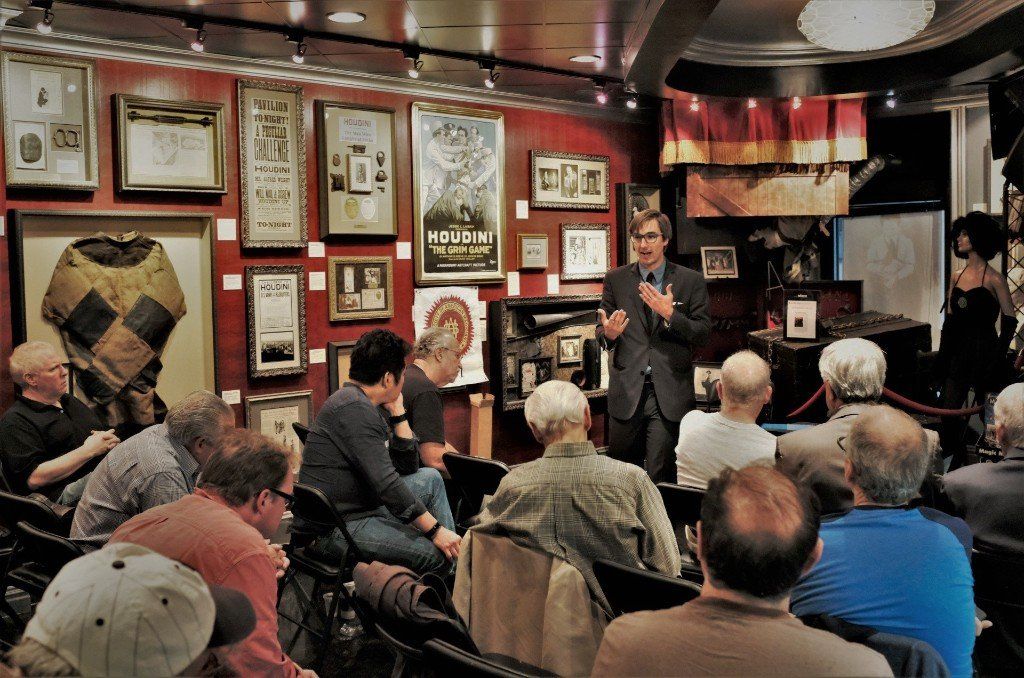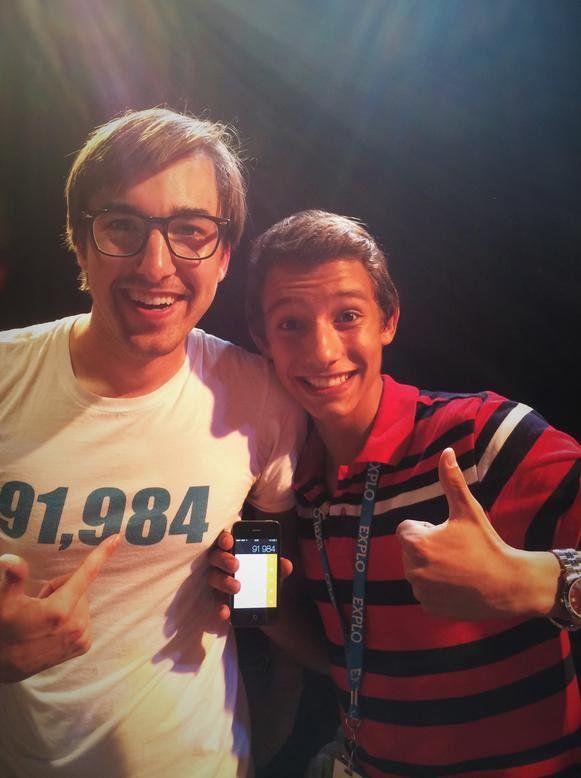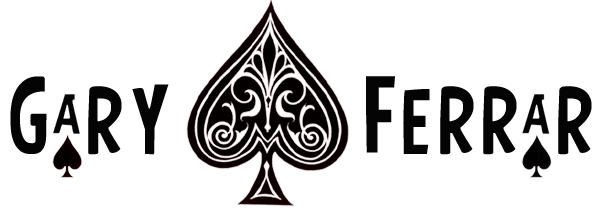The Magic Behind Professional Magicians
Lecturing to the oldest secret magic society in the USA.
A few years ago, I had the distinct honor of lecturing to the Society of American Magicians Parent Assembly #1. This is the oldest magic society chapter in the USA, and Harry Houdini was a previous president. Below are some excerpts from that lecture.

[LATE] INTRODUCTION
I came into professional magic late. I dabbled in middle school, as we all do, and then, unlike you, my equipment sat gathering dust for the next 10 years. I went to school to be a theater director and fresh out of college, I met a girl at an audition who mentioned that she worked for
Starlight foundation, which was a non-profit that sponsored visit to pediatric units by entertainers. I said that I knew a few card tricks and pretty suddenly, I was right back in it. Within a year, I was visiting five hospitals a week, performing bedside for sick children, one at a time. This meant I was getting paid to do about fifty very low-stakes mini magic sets every week. The sicker kids were there for multiple weeks and so I quickly had to expand my repertoire. Unlike most magicians, my practice and development didn’t happen locked away in my bedroom, it didn’t happen at magic camp, and it didn’t happen jamming with other magicians. It happened in front of a live audience, day after day. Admittedly, this led to some bad habits, but it also created a very unique opportunity. Some of the children were there with a broken bone, while others were there with terminal cancer. I remember many of them 15 years later. And I rarely knew what I was walking into until I opened the door. I would walk in, listen to them closely, and immediately adapt my material, my patter, and my style based on who was in the room and what it felt like they needed. My magic from day one, was built in collaboration with my audience.
KEEPING IT FRESH
An audience can tell if an act is stale. They can tell if you’re bored. They can tell if you’ve said the patter a thousand times, even if you’re a really great actor. And the only way, (I’ll repeat this because I firmly believe it), the ONLY WAY and audience becomes truly excited during your performance, is if they feel like they are experiencing something that is unrepeatable. Audiences feel a responsibility to watch something if they know it will never exist again. The irony with magic is that you can only get really good at an effect by doing it so often that you get bored by it. By nature, once we’re good at it, we’re already sick of it. So how do I stay excited about routines that I've been performing for 10 years? By allowing for and encouraging the unexpected. It makes it fun for me, which makes it valuable for the audience. There is also tremendous crossover to virtual, which you can read about in my post, How To Be a Fun and Engaging Virtual Performer.
MIND GAMES
I do about four shows a week. The routines are very set and there are certainly times where I suddenly get that feeling of “have I said this to them already?” One way I like to stay present is by adding in challenges that no one is aware of. Some of my favorites include:
- I’m not going to move from this spot for a whole trick
- I’m going to use synonyms for my entire patter
- I’m going to use my face to express more
- I’m going to whisper as much of this patter as possible
When apply these limitations, you start to discover new things in your material. And that freshness is displayed to your audience in subtle ways that make them feel like the show is new, like it’s made just for them. And ultimately, your show gets better.
USING VOLUNTEERS
Allowing for and encouraging the unexpected is most easily accomplished by using volunteers. I scan the audience and always make a point to call on people who are weird. If you choose someone strange, i.e. the only person with their shoes off, or the lady who just spilled water on herself, or the guy who looks like Mr. Clean, it makes all the difference. Just one line, one joke that you can think of well in advance of calling on them, turns your performance into a once-in-a-lifetime moment. And people remember those moments.
If there is a child in the audience, you MUST use them. Kids are far less predictable than adults, and you can use this to your advantage. Those boring adult brain patterns don’t exist yet and I've never asked a child an interesting question and received a boring answer.
What do you do for a living? What do you think is in this bag? Who’s your favorite person in the world?
I know improv isn't for everyone, but it doesn't need to be you doing the work. Just let the kid respond. If you give them space, they will fill it. Which is part of what makes
my kids magic show so much fun for me.
It’s worth noting that all of these participants are used for quick moments. I’m not using a child, or someone who might be highly unpredictable, if I’m selecting someone for a complex effect with pseudo-hypnosis or dual reality. For those effects, you really do need to find the right person? The wrong way to do this is to say: “I need a volunteer from the audience.” That’s like looking for a wife at the strip club. It’s just not going to work. Instead, let’s reverse engineer it. What are the signs of an ideal volunteer? Yes, I’m looking for someone dressed well. Yes, I’m looking for someone sitting up and engaged. But the number one thing I need in a volunteer is a picture-perfect reaction. Even if they are a little difficult to work with, I’ll take it. Some people are naturally more expressive than others and nothing is worse than pulling off a major miracle and having your volunteer shrug. The entire audience doesn’t realize it, but they are all living vicariously through that volunteer. And whatever reaction that volunteer has, will magically get send out and live inside every single person that is watching. And that’s extremely powerful. So I use the first few effects in my show to scan the audience and make a mental note of the most effusive people. And when I choose them later in the set, they have no idea that they've already auditioned for the role.
In order to get hands up, I’m a big fan of asking questions. Something that fits the motif of the effect. “Has anyone ever walked into a room and forgotten what they went in there to get?” or “Is there anyone here who has known someone else that’s here for over 15 years?” These questions get people engaged, it provides a graceful transition into their participation, and it supports the general plot line of your effect. There are also ways to guarantee you get who you want. “Who here owns a dog?” can be followed with, “Good, cause I’m looking for someone who doesn’t have one.”
VOLUNTEER MANAGEMENT:
I’ve experimented with many different ways of keeping volunteers in check. Here’s what works for me. I find that if there’s no physical contact, the volunteer is much more likely to wander. Give a handshake as they approach. Place a hand on their shoulder. Guide them to the spot I’d like and give their shoulder a little squeeze. It’s a very subtle display of dominance that sets the tone for the performance. I’ll then back up and look at them for a second before saying “perfect”. They don’t know what this is in reference too, and since volunteers generally like to “get it right”, they’ll tend to just not change or do anything. If they seem to be talking over me, I’ll ask them to look out at the crowd and focus on their breathing. No one can breathe and talk at the same time. I end up with a silent volunteer that’s exactly where I want them. I’ve never said, “don’t move”, and I’ve never said, “don’t speak”. Never verbally communicating these instructions is especially useful with child volunteers, as it gives them nothing to rebel against.
VOLUNTEER BEHAVIOR:
If a volunteer does something amazing, write it down after the show, and figure out how to duplicate it. There is always a way to get the response you need. As a child, I watched Mac King’s magic show, riveted because I saw all these moments that were unique to those volunteers. My parents let me watch it again, and I was blown away to see that all of those amazing moments were back! It was amazing to see volunteers behave exactly the same each time. I couldn’t believe it. She ALSO signed the card on the wrong side. He ALSO tried to photograph the cloak of invisibility. We all know that Mac’s not really invisible under the cloak, but no one sees the invisible cues he’s giving to his volunteers. That’s the real magic.
It’s worth taking a moment to say that it’s never too late to back out of a volunteer choice. I’ve seen many performers feel trapped in their choice and try to muscle through a routine with a bad volunteer. It’s always awkward and it’s never worth it. Keep in mind that there is no expectation for what you’re going to do with this person, so it’s always fine to cut things short and move on.
STAGE AUDIENCES
CHALLENGES
Audiences like a challenge. Many performers shy away from the “us v. them” approach. And when strolling, it doesn’t work. But a playful battle makes people so engaged on stage. I hint at the battle, giving cues for people to give me a hard time. I perform an “off by two” reveal, that was always the same. But the first time that I was asked what was on the back of my prediction before turning it around, the reveal got the largest reaction it ever had. I decided to try to replicate that as much as possible. I started mentioning that it was a 50/50 chance, right before revealing that there was something in the envelope. This improved the odds that someone would questions what was on the other side, but not enough. I decided to take the index card out and subtly peak at both sides in the first moment, so that people realize on their own that there is probably something on the opposite side of the card. This improved the odds even more. I started to furrow my brow after the first reveal, as if wondering why they weren’t responding that well, which improved the odds even more. I’m now at about 80 percent, and hopefully that can keep improving.
THE EASY WAY
The easiest way to increase a reaction to your effect is to make a trick go wrong and then save it. It’s an emotional roller coaster ride with a cathartic Obviously, you only get to play that card once in a set. I save it for my finale, where a sealed envelope given out at the top of the show, turns out to be wrong. I stretch that moment for all it’s worth. Reinforcing how good the rest of the show was, apologizing to the host, until people would give anything for me to be able to save the moment. And when I do, people’s reactions are about quadruple what they are if the envelope had been right.
Even though you can only do that once, I do play with the theme throughout my show. Little lines of doubt, such as “ohh, I don’t know if I can do it from this far away” really do bring people to the edge of their seats.
APPLAUSE (BUT NOT FOR YOU)
I use the line “give yourselves a round of applause” several times in my show. And I really do mean it because they’re doing a great job. They deserve encouragement. But you, as the performer, don’t need applause. I usually close my PK touch routine with “Thank you. I have goosebumps. That was beautiful. You can both make your way back to your seats.” And as they go back, people watch them, quietly, as they digest the moment and revel in it, in a way they wouldn’t have if I had fallen into the stereotypical “please give both my assistants a big round of applause”. People pay attention if you fight stereotype.
THE END
The audience is very receptive the external factors at the end of a powerful performance. Please remember that the experience does not end at the end of the show. You set the tone and then you have to send it off. I bring speakers to all shows, mainly so that I can play some music right after I finish. Because if the room immediately goes to hush whispers while I awkwardly pack up my things, the mood will drop pretty quickly. But if you can play a song that supports people’s natural emotional response, it will sustain that mood for much, much longer. I use an app for android simply called Audio Cues. If you’re interested in adding more audio into your show, this little app is a great start. It can control fade times, cross fades, song edits, and can easily be operated during your show. The free version generously allows for 2 shows with 10 cues per show.
At the end of your show, you probably have some people who come up to speak with you, congratulate you, etc. I find the most important question to ask them is, “what as your favorite moment?”. First, this gives you excellent feedback for next time. Second, they may have not even considered what their favorite moment was, but by asking, it brings it into focus for them as well. They’re more likely to remember it for a longer period of time. I remember seeing lots of magic shows, but I remember very few of the tricks. By asking people to recall a moment from the show, you’ve cheated by secretly reinforcing that synapse jump in their brain.
STROLLING MAGIC
KEEP IT CASUAL
Approaching with “Hi, how are you?” will almost never get a great answer. And that’s exactly what I want. I love starting with a clean state, as vanilla as possible. It brings me back to my early hospital room days. Don’t offend, just get in the door and analyze. If I’m strolling, I make sure to wear what most of the guests are wearing. Often, the first thing I do when I show up to a gig, is to take off my tie. I want to be relatable. I approach a group with a drink in hand instead of a deck of cards. “Hi, how are you?” doesn’t give a chance for “No thanks”, or “We’re not interested” I start asking questions, nothing crazy, but enough to get them talking and the magic comes in as an afterthought, in a way that is appropriate for the mood of that crowd.
BE AGGRESSIVE
I know this counteracts what I just said, but once you’ve established a relationship with a group, go to town! As a strolling magician, I find I’m mainly hired to help get people’s guards down so they can loosen up and have fun. So I’ll swap people’s drinks around, tell the most bored person that he looks the most bored, and in general start to deconstruct social graces. Of course, you need to read reactions carefully as you do this, especially for corporate events, but the payoff will be huge if it’s done well and make a work event not feel like "work".

LOCATION
New York, New York
(will travel)
CONTACT ME
© 2024
Gary Ferrar

